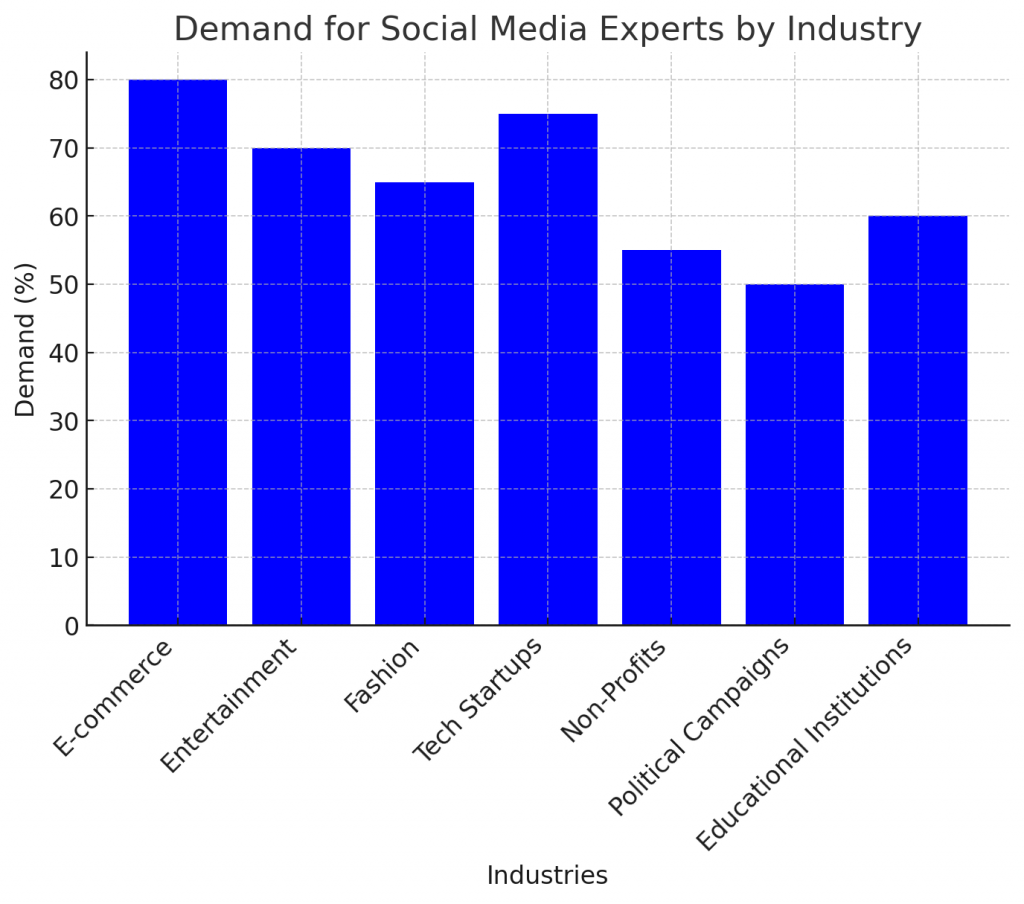Mastering Rate Determination for Remote Social Media Roles
Introduction
In today’s digital-driven era, the demand for social media professionals has skyrocketed. Companies, irrespective of their size or domain, recognize the invaluable potential of an active and strategic online presence.
As the boundaries of traditional workplaces dissolve, a considerable portion of these roles has transitioned to remote settings, allowing talent and businesses to connect irrespective of geographical constraints. While this shift has unlocked numerous opportunities, it also brings forth a daunting question for many professionals: How do I set my rates in a global, competitive market?
Determining the right rate isn’t merely about evaluating one’s skills; it’s a delicate balance of understanding market dynamics, self-worth, scope of work, and the evolving landscape of remote employment.
Charging too little can undervalue your expertise, while pitching high might alienate potential opportunities. This article aims to guide you through the intricacies of setting your rates in remote social media roles, ensuring you’re compensated fairly for your expertise, experience, and the value you bring to the table.
Whether you’re just venturing into the remote workspace or are a seasoned professional seeking guidance on rate adjustments, this comprehensive guide promises valuable insights tailored for the modern social media expert.
1. Understanding the Remote Social Media Landscape
1.1. The Demand for Social Media Professionals
As businesses recognize the power of digital platforms in shaping brand perceptions and driving engagement, the need for adept social media professionals has never been higher.
- Growth of Digital Marketing and the Need for Skilled Practitioners: The last decade has witnessed an exponential rise in digital marketing spend. Social media, with its ability to directly connect brands with consumers, plays a pivotal role in this evolution. With platforms like Instagram, Twitter, LinkedIn, and TikTok offering unique audience segments, businesses seek specialists who can craft platform-specific strategies to maximize reach and engagement.
- Industries and Sectors with the Highest Demand: While nearly all sectors have embraced social media to some extent, industries like e-commerce, entertainment, fashion, and tech startups have been particularly aggressive in their digital pursuits. Moreover, non-profits, political campaigns, and educational institutions are increasingly leveraging social media for outreach, engagement, and awareness.

1.2. Types of Remote Social Media Roles
The realm of social media is vast, and so are the roles within it. Understanding these can help professionals tailor their rates based on specific responsibilities and expertise.
- Full-time vs. Part-time Positions: A full-time remote role often entails comprehensive management of a brand’s social media presence, including content creation, strategy, and analytics. Part-time roles might focus on specific aspects, like community management or content curation.
- Freelance or Contract Roles: Many businesses, especially startups or those looking for project-specific expertise, opt for freelance professionals. These roles might involve launching a new product, managing an advertising campaign, or revamping the existing social media strategy.
- Specializations: The world of social media offers myriad specializations. From content creators who craft engaging posts to analytics experts dissecting user data for insights, each specialization brings its own value. Other niches include influencer collaboration managers, social media ad specialists, and strategy consultants.
1.3. Global Market Dynamics
Operating in a remote setting means your potential client or employer pool is global. This vast landscape offers opportunities but also introduces complexities in rate determination.
- The Impact of Working in a Globalized Job Market: Remote roles open doors to international opportunities, but they also bring competition from regions with varying living costs. While a rate might be competitive in one country, it might be below par in another.
- Regional Disparities in Pay and Cost of Living: A social media manager in San Francisco might command a significantly different rate than one in Bali, purely based on living costs. Professionals need to strike a balance between local market rates and the broader global landscape.
In essence, understanding the remote social media landscape is foundational in setting appropriate rates. Recognizing the demand, the nature of roles, and the dynamics of a global market can equip professionals with the insights needed to position and price themselves competitively.
2. Factors to Consider When Setting Your Rates
2.1. Your Level of Expertise and Experience
Your experience and expertise serve as key determinants in your rate-setting journey. It’s essential to honestly assess where you stand to ensure you’re competitively and fairly priced.
- Entry-level vs. Seasoned Professionals: An entry-level professional, while bursting with fresh ideas, might lack the industry experience that seasoned professionals bring to the table. Experienced professionals often command higher rates due to their proven track records, expertise across platforms, and ability to handle complex campaigns.
- Specialized Skills and Certifications: Holding certifications from reputable institutions or platforms can bolster your credentials. For instance, a Facebook Blueprint certification might add weight to your expertise in Facebook advertising. Similarly, experience with tools like Hootsuite, Buffer, or Sprout Social can also influence your rate.
2.2. The Scope of the Project or Role
A clear understanding of the project’s demands or the job’s responsibilities is crucial in determining an appropriate rate.
- Ongoing Monthly Management vs. One-off Campaigns: Managing a brand’s entire social media presence typically involves a long-term commitment, requiring consistent effort, while one-off campaigns might demand intensive short-term work. The duration, intensity, and range of responsibilities can all influence the rate.
- Size of the Company or Client: A startup might have budget constraints, but working with them could offer creative freedom and growth opportunities. In contrast, established brands might offer higher compensation but may come with stringent guidelines and expectations.
2.3. Market Research and Industry Benchmarks
Staying informed about industry standards and what peers are charging can offer valuable reference points.

- Utilizing Platforms for Rate Insights: Platforms like Glassdoor and Payscale provide insights into salary ranges for various roles across regions. For freelancers, platforms like Upwork or Fiverr can offer glimpses into what professionals with similar skills are charging.
- Networking and Discussion with Peers: Engaging in industry forums, attending webinars, or being part of social media professional groups can offer anecdotal insights into rate standards. Open discussions with peers can also provide clarity and ensure you’re in line with industry norms.
Setting your rates isn’t a one-size-fits-all formula. It requires introspection, understanding the job’s demands, and staying updated with industry benchmarks. By considering these factors in tandem, professionals can arrive at a rate that not only reflects their worth but also aligns with market standards.
3. Pricing Models for Remote Social Media Professionals
3.1. Hourly Rate
Many professionals prefer the straightforwardness of charging by the hour, but this model requires careful consideration to ensure fairness for both parties.
- Advantages and Potential Pitfalls: Hourly rates can be beneficial as they directly compensate for the time invested. They can be especially advantageous for unpredictable projects where the scope isn’t clearly defined. However, as professionals become more efficient, they might find themselves earning less for the same task. There’s also the challenge of tracking hours and ensuring clients trust the reported time.
- When to Consider This Model: Hourly rates are ideal for projects with ambiguous scopes or when working with a new client where the exact demands aren’t clear. They can also suit tasks that vary significantly in required effort from one assignment to the next.

3.2. Fixed or Project-based Rate
This model involves setting a fixed price for a specific project, offering clarity and predictability for both the professional and the client.
- Breaking Down Deliverables and Milestones: To set a project-based rate, it’s essential to clearly define deliverables. This might involve detailing the number of posts, the platforms covered, or specific campaign outcomes. Setting milestones, especially for more extended projects, can also help in phased billing.
- Factors to Account for in This Model: When setting a project rate, consider all aspects, including research, content creation, meetings, revisions, and analytics. It’s easy to overlook indirect time investments, so ensure a holistic assessment to avoid underselling your services.
3.3. Retainer Model
A retainer involves a client paying a set fee, typically monthly, for ongoing services. This model offers stability and fosters long-term professional relationships.
- Establishing Long-term Relationships with Clients: Retainers work best when there’s an ongoing demand for services, ensuring a steady income stream for professionals. It’s especially prevalent in social media management roles where continuous engagement is required.
- Setting Expectations and Deliverables for Ongoing Work: It’s crucial to outline what the retainer covers. This could involve specifying the number of posts, engagement metrics, or any other deliverables. Periodic reviews can also be incorporated to adjust the scope based on evolving needs.
Different pricing models cater to varying project demands and professional preferences. While it’s essential to understand the intricacies of each, it’s equally important to be flexible. The nature of remote work is dynamic, and professionals might often find themselves juggling multiple models based on client needs and project specifics. Choosing the right model not only ensures fair compensation but also fosters trust and clarity in professional relationships.
4. Negotiating Your Rates
4.1. The Art of Effective Communication
Negotiation is as much about listening as it is about asserting your value. Effective communication can bridge gaps in understanding and foster mutually beneficial agreements.
- Conveying Value and ROI to Potential Clients or Employers: Before diving into numbers, highlight the value you bring. This could be in the form of increased engagement, brand visibility, or conversions from past projects. Use data and examples to illustrate your impact, making a compelling case for your proposed rate.
- Balancing Assertiveness with Flexibility: While it’s crucial to know your worth and stand by it, it’s also essential to be open to discussions. Sometimes, a slightly reduced rate could lead to long-term collaborations or other non-monetary benefits like exposure, learning opportunities, or flexibility in work hours.
4.2. Addressing Rate Pushbacks
Every professional, at some point, faces pushback on their rates. Handling these with grace and tact can sometimes turn apprehensions into agreements.

- Constructive Responses to Rate Challenges: Instead of getting defensive, seek to understand the client’s reservations. Offer breakdowns of your services, emphasizing the quality and expertise you bring. If they have a fixed budget, explore ways to adjust the scope of work to align with it without undervaluing your services.
- Demonstrating the Cost-effectiveness and Value of Your Services: Sometimes, clients might not be aware of the industry norms or the intricacies of social media tasks. Educate them on the time-consuming nature of crafting quality content, the expertise required for effective strategy, or the value of consistent brand presence on social platforms.
4.3. Periodically Re-evaluating and Adjusting Rates
The digital landscape, and especially the realm of social media, is ever-evolving. As platforms change, algorithms update, and new trends emerge, your expertise and the demand for your services might also shift.
- Keeping Pace with Industry Shifts and Personal Growth: As you upskill, take on more significant projects, or achieve notable successes, it’s essential to reflect these in your rates. Stay updated with industry benchmarks and adjust your rates accordingly.
- Factors Prompting a Rate Review: Regular intervals, like annually or bi-annually, are good times for rate reviews. Other triggers could be gaining a significant certification, achieving a notable success with a campaign, or when there’s a surge in demand for specific skills you possess.
Negotiation is an integral aspect of professional engagements, more so in freelance or remote roles where standardized rate cards are rare. By approaching these discussions with preparation, understanding, and clarity, professionals can ensure they’re adequately compensated, fostering relationships built on mutual respect and understanding.
5. Tips for Financial Stability in Remote Social Media Roles
5.1. Diversifying Revenue Streams
In the unpredictable world of freelance and remote work, diversification can be the key to consistent income.
- Juggling Multiple Clients or Roles: Instead of relying on a single primary client, consider managing a few different accounts or projects. This not only safeguards against the financial instability of losing a singular client but also allows you to gain experience across sectors and platforms.
- Exploring Related Services: Diversify within your domain. If you’re primarily into content creation, consider offering consultation services, strategy planning, or social media analytics reviews. These additional services can add to your revenue and enhance your portfolio.
5.2. Setting Aside for Taxes and Benefits
One of the often-overlooked aspects of freelancing or contract roles is planning for benefits and taxes, which traditional employers usually handle.
- Financial Planning for Freelancers and Contractors: Without the cushion of employer-provided benefits, it’s crucial to plan ahead. Set aside a portion of your earnings for health insurance, retirement funds, and any other benefits you deem essential.
- Importance of Healthcare, Retirement, and Other Considerations: While it’s tempting to focus only on present earnings, it’s vital to invest in health insurance and retirement plans. These long-term investments ensure that you’re covered during emergencies and can lead a comfortable life post-retirement.
5.3. Continuous Learning and Skill Enhancement
In the rapidly evolving realm of social media, staying updated is not optional—it’s crucial.
- Investing in Courses and Certifications: Platforms and their algorithms change, new platforms emerge, and user behaviors shift. Investing in courses keeps you updated, making sure you continue to offer relevant and effective services to your clients.
- Adapting to Industry Changes for Rate Justification: As you upskill and adapt to the industry’s changing demands, it becomes easier to justify your rates and even ask for increments. Demonstrating that you’re at the forefront of social media trends can be a significant selling point.
Financial stability in remote roles, especially in domains as dynamic as social media, requires proactive planning, diversification, and continuous learning. By ensuring multiple revenue streams, planning for the future, and staying updated with industry shifts, professionals can build a rewarding and sustainable career in remote social media roles.
Conclusion
As the digital frontier continues to expand, the role of social media professionals in shaping online narratives and driving brand engagements has become paramount. With this surge in demand, a considerable segment of the workforce has transitioned to remote roles, necessitating a reassessment of traditional compensation structures. While the flexibility and vast opportunities offered by remote work are undeniable, they come with their own set of challenges—chief among them being determining a fair and competitive rate.
Setting rates in remote social media jobs isn’t just a reflection of one’s skills or the hours they put in; it’s a testament to their market understanding, adaptability, and the unique value proposition they bring to the table. From understanding global market dynamics to negotiating with potential clients and employers, the journey is intricate. Yet, with informed strategies, continuous learning, and an unwavering commitment to one’s craft, it’s possible to strike a balance that ensures both financial stability and professional fulfillment.
In this ever-evolving domain, one principle remains constant: value begets value. As social media professionals continue to enhance their skills, adapt to changing platforms, and deliver consistent results, their rates will be a mere reflection of the invaluable expertise they offer. In the vast, interconnected realm of the internet, where every post, tweet, or story can shape perceptions, the role of a skilled social media expert is priceless. And as with all priceless things, it deserves to be valued justly.
Additional Resources
To navigate the intricate landscape of setting rates in remote social media roles, a plethora of resources can guide, inform, and empower professionals. Whether you’re starting out or are a seasoned expert seeking to recalibrate your rates, these resources can offer invaluable insights and tools.
Online Courses for Effective Pricing Strategies:
- Udemy: “Freelance Pricing and Negotiation” – This course offers insights into understanding your worth, setting rates, and mastering the art of negotiation.
- Coursera: “Financial Management Capstone” – A comprehensive overview that provides tools and frameworks for financial decision-making, including pricing models and strategies.
Books on Pricing and Freelance Financial Management:
- “Breaking the Time Barrier: How to Unlock Your True Earning Potential” by Mike McDerment and Donald Cowper: Delve deep into understanding the value-based pricing model, focusing on delivering value to clients.
- “The Freelancer’s Bible: Everything You Need to Know to Have the Career of Your Dreams—On Your Terms” by Sara Horowitz: A guide that covers everything from setting rates to managing freelance finances, making it a must-read for any remote professional.
Links to Platforms Offering Market Rate Insights:
- Glassdoor’s Salary Tool: Gain insights into average salaries for social media roles across different regions and company sizes.
- PayScale: A comprehensive platform that offers insights into what professionals in similar roles and regions are earning.
Networking and Industry Forums:
- LinkedIn Groups: Platforms like “Social Media Examiner” and “Social Media Professionals” on LinkedIn offer a space for professionals to discuss, share, and seek advice on industry norms and rate standards.
- Local Networking Events or Webinars: Often, local co-working spaces, industry associations, or platforms like Meetup host events where professionals can network and gain insights into local market rates and demands.

Financial Planning Tools for Freelancers:
- QuickBooks Self-Employed: Tailored for freelancers and contractors, this tool helps track expenses, manage invoices, and plan for taxes.
- AND.CO: A comprehensive platform that offers proposals, contracts, invoicing, expense tracking, and time tracking, ensuring freelancers have a holistic financial overview.
In the journey of setting rates and achieving financial stability, continuous learning and staying updated are paramount. These resources, from courses to tools, aim to empower social media professionals, ensuring they’re equipped to navigate the challenges and opportunities of the remote work landscape. By leveraging these, professionals can confidently set their rates, ensuring they reflect the value, expertise, and unique insights they bring to their roles.

